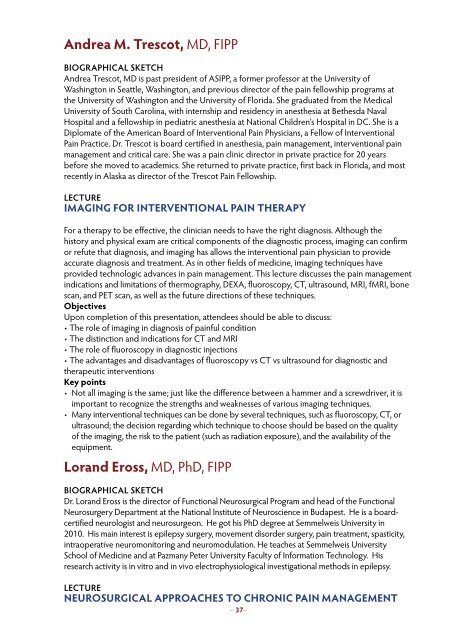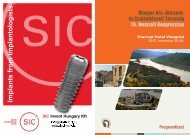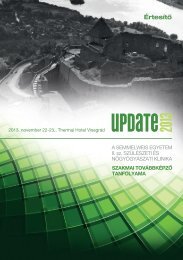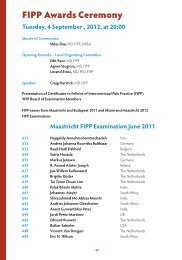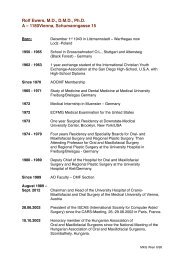in PDF format
in PDF format
in PDF format
- No tags were found...
Create successful ePaper yourself
Turn your PDF publications into a flip-book with our unique Google optimized e-Paper software.
Andrea M. Trescot, MD, FIPPBiographical SketchAndrea Trescot, MD is past president of ASIPP, a former professor at the University ofWash<strong>in</strong>gton <strong>in</strong> Seattle, Wash<strong>in</strong>gton, and previous director of the pa<strong>in</strong> fellowship programs atthe University of Wash<strong>in</strong>gton and the University of Florida. She graduated from the MedicalUniversity of South Carol<strong>in</strong>a, with <strong>in</strong>ternship and residency <strong>in</strong> anesthesia at Bethesda NavalHospital and a fellowship <strong>in</strong> pediatric anesthesia at National Children’s Hospital <strong>in</strong> DC. She is aDiplomate of the American Board of Interventional Pa<strong>in</strong> Physicians, a Fellow of InterventionalPa<strong>in</strong> Practice. Dr. Trescot is board certified <strong>in</strong> anesthesia, pa<strong>in</strong> management, <strong>in</strong>terventional pa<strong>in</strong>management and critical care. She was a pa<strong>in</strong> cl<strong>in</strong>ic director <strong>in</strong> private practice for 20 yearsbefore she moved to academics. She returned to private practice, first back <strong>in</strong> Florida, and mostrecently <strong>in</strong> Alaska as director of the Trescot Pa<strong>in</strong> Fellowship.LectureImag<strong>in</strong>g for Interventional Pa<strong>in</strong> TherapyFor a therapy to be effective, the cl<strong>in</strong>ician needs to have the right diagnosis. Although thehistory and physical exam are critical components of the diagnostic process, imag<strong>in</strong>g can confirmor refute that diagnosis, and imag<strong>in</strong>g has allows the <strong>in</strong>terventional pa<strong>in</strong> physician to provideaccurate diagnosis and treatment. As <strong>in</strong> other fields of medic<strong>in</strong>e, imag<strong>in</strong>g techniques haveprovided technologic advances <strong>in</strong> pa<strong>in</strong> management. This lecture discusses the pa<strong>in</strong> management<strong>in</strong>dications and limitations of thermography, DEXA, fluoroscopy, CT, ultrasound, MRI, fMRI, bonescan, and PET scan, as well as the future directions of these techniques.ObjectivesUpon completion of this presentation, attendees should be able to discuss:• The role of imag<strong>in</strong>g <strong>in</strong> diagnosis of pa<strong>in</strong>ful condition• The dist<strong>in</strong>ction and <strong>in</strong>dications for CT and MRI• The role of fluoroscopy <strong>in</strong> diagnostic <strong>in</strong>jections• The advantages and disadvantages of fluoroscopy vs CT vs ultrasound for diagnostic andtherapeutic <strong>in</strong>terventionsKey po<strong>in</strong>ts• Not all imag<strong>in</strong>g is the same; just like the difference between a hammer and a screwdriver, it isimportant to recognize the strengths and weaknesses of various imag<strong>in</strong>g techniques.• Many <strong>in</strong>terventional techniques can be done by several techniques, such as fluoroscopy, CT, orultrasound; the decision regard<strong>in</strong>g which technique to choose should be based on the qualityof the imag<strong>in</strong>g, the risk to the patient (such as radiation exposure), and the availability of theequipment.Lorand Eross, MD, PhD, FIPPBiographical SketchDr. Lorand Eross is the director of Functional Neurosurgical Program and head of the FunctionalNeurosurgery Department at the National Institute of Neuroscience <strong>in</strong> Budapest. He is a boardcertifiedneurologist and neurosurgeon. He got his PhD degree at Semmelweis University <strong>in</strong>2010. His ma<strong>in</strong> <strong>in</strong>terest is epilepsy surgery, movement disorder surgery, pa<strong>in</strong> treatment, spasticity,<strong>in</strong>traoperative neuromonitor<strong>in</strong>g and neuromodulation. He teaches at Semmelweis UniversitySchool of Medic<strong>in</strong>e and at Pazmany Peter University Faculty of In<strong>format</strong>ion Technology. Hisresearch activity is <strong>in</strong> vitro and <strong>in</strong> vivo electrophysiological <strong>in</strong>vestigational methods <strong>in</strong> epilepsy.LectureNeurosurgical Approaches to Chronic Pa<strong>in</strong> Management– 37–


